30.03.2023
SpaceX Rocket to Deliver Military Satellites from Vandenberg SFB
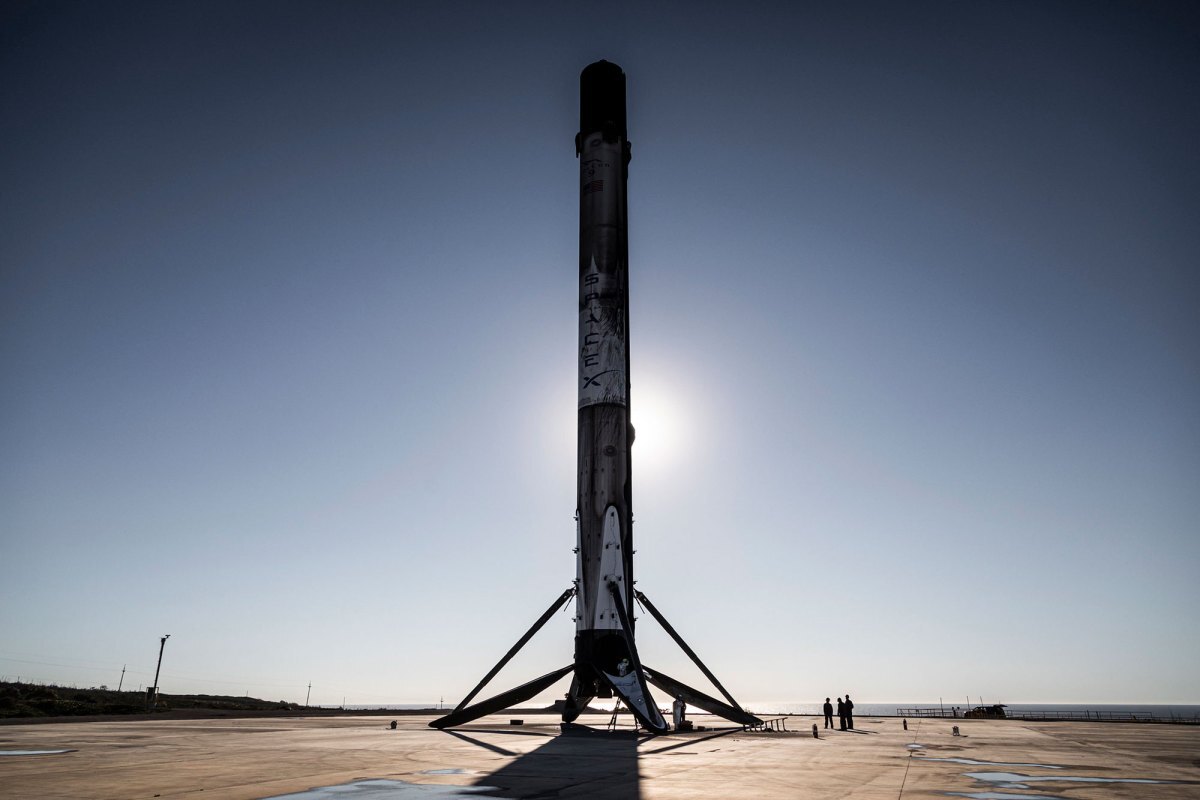
A new generation of military satellites will aim to launch as soon as Thursday from Vandenberg Space Force Base aboard a Falcon 9 rocket for a mission that also will include the first-stage booster’s return to the Central Coast.
The two-stage rocket built by Space Exploration Technologies will lift off from Space Launch Complex-4 on South Base and return 7 to 8 minutes later to the landing site west of the departure location.
Neither SpaceX nor the military had released the planned launch time as of Tuesday night.
However, prior to launches, notices to pilots and boaters are issued to keep aircraft and sea vessels out of the area.
The launch reportedly will occur between 7:14 a.m. and 9:08 a.m. Thursday, although the team also has similar launch periods reserved for Friday and Saturday.
SpaceX and military officials are expected to release the planned launch time in the coming days.
A return to Vandenberg for the first-stage booster once it completes its chores may bring sonic booms audible in Santa Barbara, San Luis Obispo and Ventura counties.
The rocket will carry a payload for the Space Development Agency, once an independent organization in the Defense Department and now part of U.S. Space Force.
The agency works to quickly deliver space-based capabilities to warfighters with an eye toward speed and lower costs for an acquisition process that typically takes years.
The rocket reportedly will carry multiple satellites under the recently renamed “Proliferated Warfighter Space Architecture” or PWSA, formerly known as the “National Defense Space Architecture.”
The Tranche 0 mission will carry the first set of satellites for a new missile tracking and data relay system.
The constellation name change won’t affect the SDA mission to be the Defense Department’s “constructive disruptor for space acquisition,” military officials said.
“Leveraging speed, delivery, and agility, SDA will continue to quickly deliver needed space-based capabilities to the joint warfighter to support terrestrial missions through development, fielding, and operation of the PWSA.”
The Vandenberg mission is one of two planned this week for SpaceX, which intends to send more Starlink satellites into orbit from Florida as soon as Wednesday afternoon.
On the West Coast, SpaceX rocket launches and landings typically attract onlookers to the Lompoc Valley.
Vandenberg has restricted access, but several locations around the Lompoc Valley provide views of the launch and landing sites, which are south of West Ocean Avenue (Highway 246).
The locations include west of Lompoc, the peak of Harris Grade Road, and near the intersection of Moonglow and Stardust roads.
Providence Landing Park, at 699 Mercury Ave. in Vandenberg Village, also is a popular gathering spot, along with West Ocean Avenue west of the Lompoc’s city limits.
A live broadcast of the mission can be found on the SpaceX website or its YouTube channel.
Quelle: Noozhawk
----
Update: 30.03.2023
.
First launch for Pentagon’s own mega-constellation set for Thursday


This artist’s concept illustrates how the Space Development Agency’s mesh network will detect and track missiles, relay data, and perform navigation and tech demo missions. Credit: Space Development Agency
The U.S. military’s Space Development Agency, established in 2019 to fast-track new national security capabilities in orbit, plans to launch the first 10 satellites for a constellation of hundreds of missile tracking and data relay spacecraft Thursday on a SpaceX Falcon 9 rocket from California.
SDA’s fleet of spacecraft, each smaller and cheaper than the military’s current crop of missile warning satellites, will improve the Pentagon’s ability to detect and track emerging threats like attacks with hypersonic missiles, then deliver the tracking data directly to ground, air, or naval forces using existing tactical radio networks. U.S. and allied forces could then shoot down the enemy missile.
“This is a pretty exciting time,” said Derek Tournear, SDA’s director, in a conference call with reporters Wednesday. “Space Development Agency was established just over four years ago, this month, and tomorrow will be the first launch of our Tranche 0 Proliferated Warfighter Space Architecture.”
The first phase of SDA’s Proliferated Warfighter Space Architecture will consist of 28 satellites scheduled for launch this year as a proof of concept for the missile tracking and data relay network, followed by more than 150 additional satellites launching in 2024 and 2025 to provide an initial operational capability.
Combining conventional tactical radio links, laser inter-satellite communications, and wide-view infrared sensors, hundreds more SDA spacecraft could launch later in the 2020s as the Pentagon ramps up efforts to counter new threats from China and Russia.
The first 10 prototype satellites, eight data relay spacecraft built by York Space Systems and two missile tracking platforms manufactured by SpaceX, will head into a 620-mile-high (1,000-kilometer) orbit after liftoff on the Falcon 9 rocket Thursday.
Launch time is set for 7:29 a.m. PDT (10:29 a.m. EDT; 1429 UTC) from Space Launch Complex 4-East at Vandenberg, a military spaceport about 140 miles (225 kilometers) northwest of Los Angeles. The Falcon 9 will head south from its launch pad, arcing toward a near-polar orbit inclined 80 degrees to the equator.
SpaceX plans to land the reusable first stage of the Falcon 9 rocket back at Vandenberg less than eight minutes after liftoff, while the upper stage continues into orbit with the 10 SDA satellites.
At the request of the military, SpaceX is not expected to provide live video coverage of the upper stage burn and deployment of the SDA satellites into orbit. The company’s live webcast of the launch will focus on the return of the booster to Landing Zone 4 at Vandenberg.
Tournear, who has led SDA since 2019, said the agency was set up to “demonstrate a completely new way to field space capabilities and to operate them.”
SDA, now part of the Space Force, plans to launch satellites in successive generations, or tranches, each introducing new technology. Military officials say SDA’s constellation will be more resilient to attack than the Pentagon’s conventional space assets, which often cost hundreds of millions or billions of dollars apiece and employ a small number of large satellites to fulfill critical national security functions like missile warning, navigation, and communications.
A network relying on numerous smaller satellites could better withstand the loss of a few spacecraft.
“We essentially have developed an architecture based on two pillars,” Tournear said. “Pillar No.1 is proliferation, hundreds and hundreds of satellites. Pillar No. 2 is spiral development. That means that we’re going to launch our spirals, or tranches, essentially every other year.”
The first 28 satellites are known as Tranche 0, with 10 spacecraft awaiting launch Thursday on a Falcon 9 rocket, and 18 more satellites planned for launch on another Falcon 9 mission in June.
“We call it our warfighter immersion tranche,” Tournear said.
Later this year, military units at Eglin Air Force Base will begin receiving data from the Tranche 0 satellites for evaluation. Tournear said U.S. Marine Corps units will also incorporate the Tranche 0 satellites during exercises in the Indo-Pacific region.
Then, sometime in early 2024, the Tranche 0 satellites will undergo perhaps their most critical test when the U.S. military checks their ability to detect and track a hypersonic missile. The military’s current fleet of early warning satellites — the Space Based Infrared System, or SBIRS, constellation — is best suited to sensing the bright thermal flash from the plume of a large ballistic missile, not the comparatively dim infrared signature of a hypersonic missile, which can evade detection as it glides and maneuvers through the atmosphere to reach its target.

The Tranche 0 phase of SDA’s satellite constellation is budgeted for $980 million, including the 28 spacecraft, two launches with SpaceX, ground systems, and operations, according to Tournear.
“The satellites that we have up there, the intent there is to get them in the warfighters’ hands so they can start developing their techniques to be able to use them, to give them the timeline to go through their training, and to allow them to start thinking about how they would use the larger constellation once we have it on orbit,” said Mike Eppolito, SDA’s Tranche 0 program director.
“So our’s is intended to be the demonstration tranche that allows them to sort of get their feet wet and start using the capabilities that we’re putting on orbit,” Eppolito said.
“Tranche 0 is made up of 28 total satellites, 20 satellites doing a tactical communication mission to show low-latency communication directly to the warfighter, and then eight satellites that we call our tracking satellites to do advanced missile detection and tracking,” Tournear said.
SDA awarded contracts for the Tranche 0 satellites in 2020, ordering 20 so-called Transport Layer data relay satellites from York Space Systems and Lockheed Martin, and eight Tracking Layer missile detection satellites from SpaceX and L3Harris.
Five of the eight York-built satellites on the first Tranche 0 launch Thursday will each have two laser communications terminals for inter-satellite links, plus a radio frequency communications payload. The other three satellites will have the same hardware, with an added tactical link for data transmission to military forces on Earth. The SpaceX-built tracking satellites each have a wide field of view infrared sensor produced by Leidos, along with two laser communication terminals.
The second Tranche 0 launch in June will carry the Lockheed Martin and L3Harris satellites into orbit, along with the remaining York and SpaceX spacecraft.
“We’re right at two and a half years from order to orbit,” Tournear said. “So we’re pretty excited to show that the model actually does work … to get the capabilities to the warfighter at speed.”
Each Tranche 0 Transport Layer data relay satellite from York and Lockheed Martin cost about $15 million, while the Tracking Layer satellites from SpaceX and L3Harris have an average cost of around $40 million. SDA has not released information about the size or mass of each satellite, or released any photos of the spacecraft during manufacturing and testing.
SDA purchased two dedicated Tranche 0 launches on Falcon 9 rockets from SpaceX in 2020 for $150 million. The agency partnered with the Naval Research Laboratory on ground systems and software development for Tranche 0.

Tournear said SDA’s emphasis on development speed, tactical needs, and a “proliferated” architecture with hundreds of satellites differentiates the agency from the work of other military space programs. Working with the Missile Defense Agency, which fields a network of sensors on the ground and in space, SDA’s objective is to get actionable missile tracking data in the hands of military forces anywhere in the world
“The warfighter is the the actual one that would be responsible for for releasing weapons in theater,” Tournear said. “Those could be the people on an Aegis ship that are releasing weapons to do an intercept on a missile. Those are the the ultimate customers. Everything we have is focused on the shooter and then working backwards from that.”
After detecting a threatening missile, the tracking satellites will transmit data on the projectile’s location and track to the Transport Layer satellites using laser communications links. Then the data relay satellites will beam the information to the ground using an existing tactical radio network.
“So the tracking satellites would be able to send data down via the transport layer, and get that fused together into a fire control solution with other data inputs,” Tournear said.
“The whole idea of the Proliferated Warfighter Space Architecture is to provide the real-time tactical data dominance for not only advanced missile threats, but any and all threats, so that the warfighter can can have complete situational awareness,” Tournear said.
The launch of the first Tranche 0 satellites was delayed from late 2022 until March due to a power supply problem discovered on the eight York-built spacecraft.
The two-and-a-half year turnaround from contract award to launch is quick by the standards of military satellite procurements. Eppolito, the Tranche 0 program director, said he hopes future generations of SDA satellites will be built and launched even faster.
“First and foremost, a global pandemic wasn’t incredibly helpful for our timeline,” Eppolito said. “I think the other thing that that we are working through on Tranche 0 that will get better with the future tranches is supply chain.
“I don’t think SDA did anything to take space being hard out of the equation here,” Eppolito said. “We’re still dealing with the same space environments, we’re still dealing with the same challenges … I think we solved a lot of those problems because of how agile we were. I think we probably don’t give enough credit to how tailored the agency is to resolve problems quickly.
SDA is geared toward finding ready-made, off-the shelf technology in commercial industry, such as satellite buses, sensors, and laser communication terminals, and quickly infuse it into military operations.
SpaceX, which has two satellites on Thursday’s launch, has built more than 4,000 small spacecraft for its Starlink broadband mega-constellation. York Space Systems, Lockheed Martin, Northrop Grumman, and L3Harris have experience in large-scale satellite manufacturing and space-based optical sensors.
For the next-generation Tranche 1 constellation. SDA ordered 126 operational Transport Layer data relay satellites last year from York Space Systems, Lockheed Martin, and Northrop Grumman, plus 28 more Tracking Layer missile detection satellites from L3Harris and Northrop Grumman.
The agency also last year purchased another 12 Tranche 1 satellites from York Space Systems for demonstration of experimentation in tactical communications and integrated broadcast services, and bought 10 satellites from Ball Aerospace to demonstrate low latency data transport and beyond line of sight command and control.
The contracts for those satellites, all comprising SDA’s Tranche 1, total nearly $3.5 billion. Including the Tranche 0 and Tranche 1 orders, SDA has procured 204 spacecraft to date.
“The launches (for Tranche 1) start in September next year and they launch one a month for the next 12 months,” Tournear said.
A draft solicitation released by the agency earlier this year suggests SDA anticipates ordering as many as 216 more satellites for the Tranche 2 Transport Layer for launches beginning in 2026.
Quelle: SN
----
Update: 2.04.2023
.
Start von SpaceX Falcon9 mit Military Satellites from Vandenberg SFB



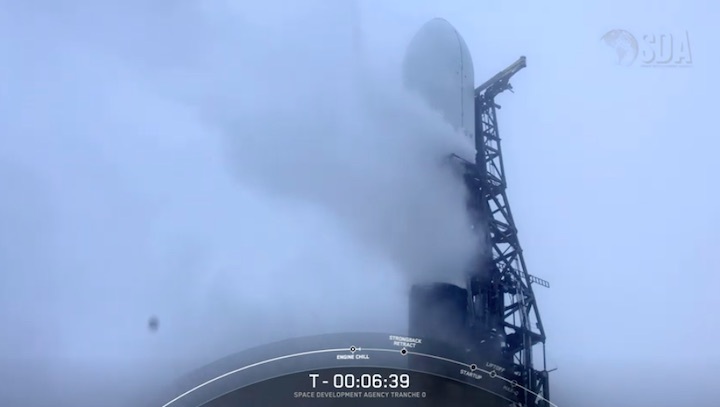








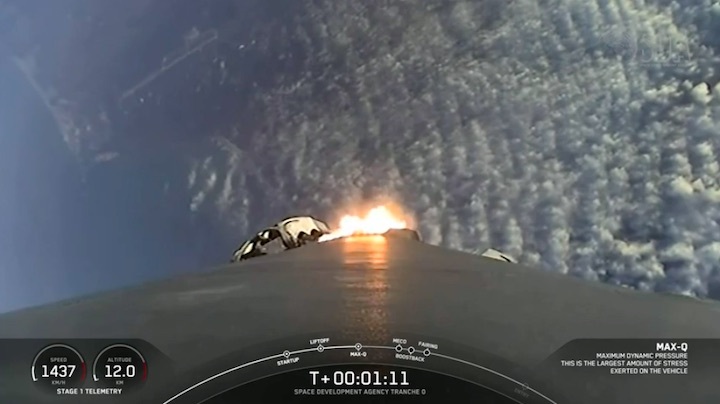




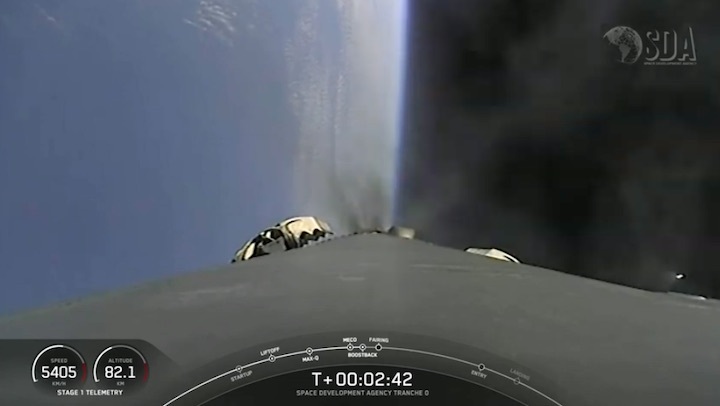

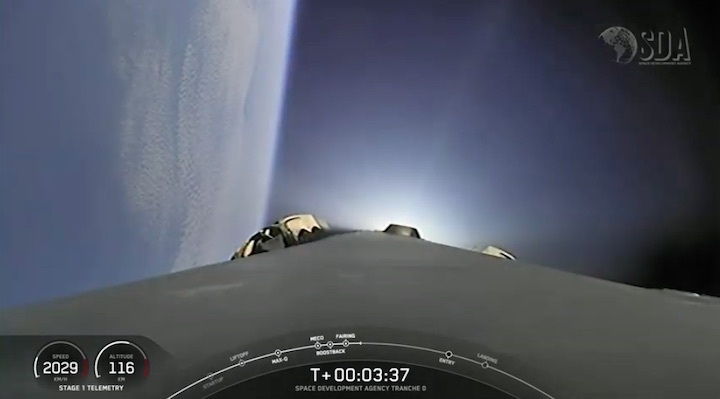



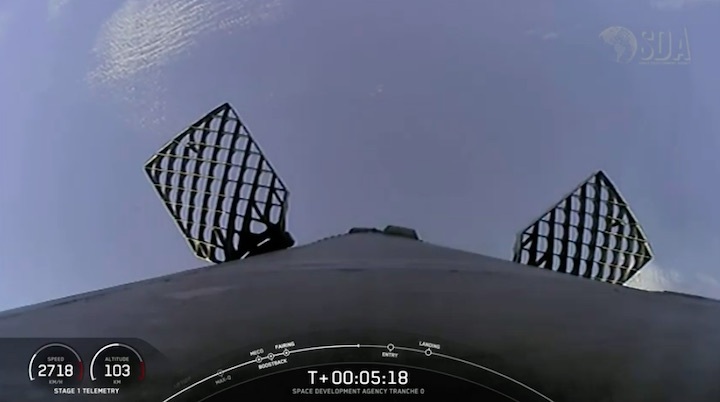
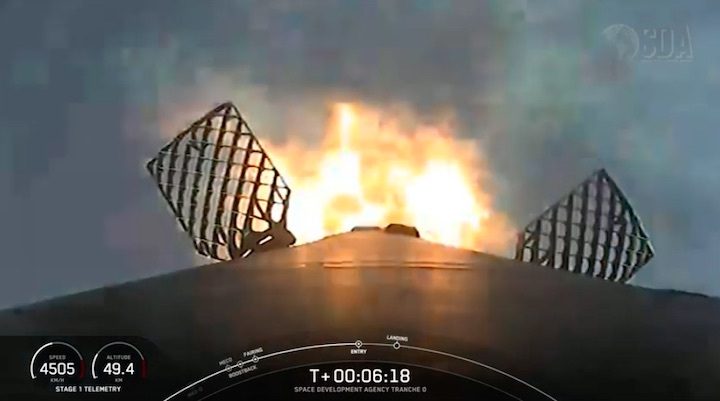
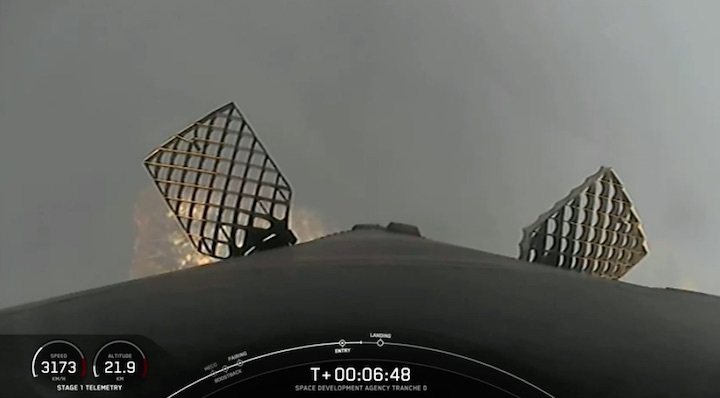
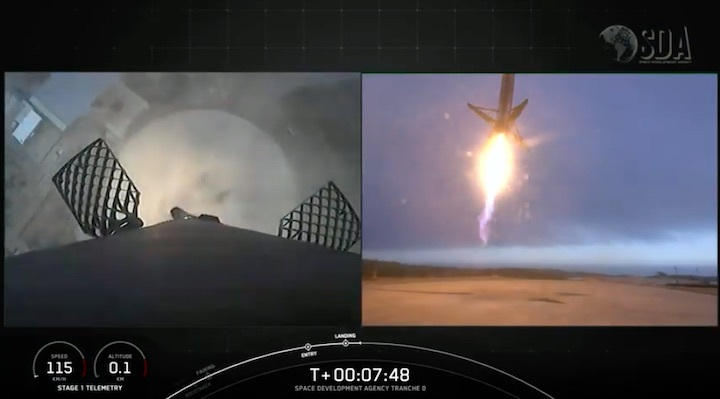



Quelle: SpaceX
